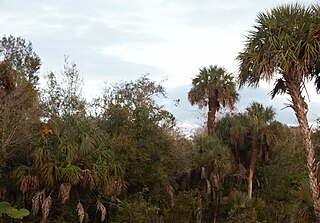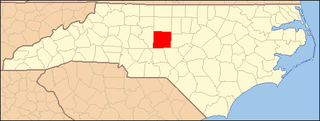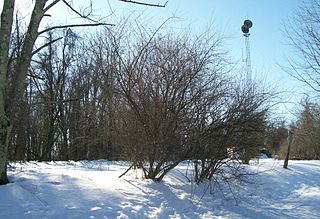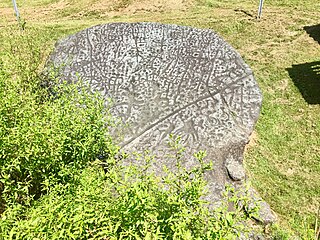Related Research Articles

Asheboro is a city in and the county seat of Randolph County, North Carolina, United States. The population was 25,012 at the 2010 census. It is part of the Greensboro–High Point Metropolitan Area of the Piedmont Triad and is home of the state-owned North Carolina Zoo.

Stagville Plantation is located in Durham County, North Carolina. With buildings constructed from the late 18th century to the mid-19th century, Stagville was part of one of the largest plantation complexes in the American South. The entire complex was owned by the Bennehan, Mantack and Cameron families; it comprised roughly 30,000 acres (120 km2) and was home to almost 900 enslaved African Americans in 1860.

Platt Island is an archaeological site off Florida State Road 29 in Collier County north of Miles City. It was added to the U.S. National Register of Historic Places in 1978. Ceramic fragments dated to about 2500 years old were found at the site, which is in the Big Cypress National Preserve.

Town Creek Indian Mound is a prehistoric Native American archaeological site located near present-day Mount Gilead, Montgomery County, North Carolina, in the United States. The site, whose main features are a platform mound with a surrounding village and wooden defensive palisade, was built by the Pee Dee, a South Appalachian Mississippian culture people that developed in the region as early as 980 CE. They thrived in the Pee Dee River region of North and South Carolina during the Pre-Columbian era. The Town Creek site was an important ceremonial site occupied from about 1150—1400 CE. It was abandoned for unknown reasons. It is the only ceremonial mound and village center of the Pee Dee located within North Carolina.

The Modoc Rock Shelter is a rock shelter or overhang located beneath the sandstone bluffs that form the eastern border of the Mississippi River floodplain at which Native American peoples lived for thousands of years. This site is significant for its archaeological evidence of thousands of years of human habitation during the Archaic period in the Eastern United States. It is located on the northeastern side of County Road 7 southeast of Prairie du Rocher in Randolph County, Illinois, United States. It was declared a National Historic Landmark in 1961.
The McLemore Site, designated by the Smithsonian trinomial 34WA5, is a prehistoric archaeological site of the Southern Plains villagers located near Colony in Washita County, Oklahoma. It is the site of a prehistoric Plains Indian village, dating from AD 1330-1360, during the Washita River phase. The site is of historic importance for being a key element helping determine the chronology of prehistoric cultures in the region. It was declared a National Historic Landmark in 1964.

The Manis Mastodon site is a 2-acre (1 ha) archaeological site on the Olympic Peninsula near Sequim, Washington, United States, discovered in 1977. During the 1977-78 excavation, the remains of an American mastodon were recovered with a 13,800-year-old projectile point made of the bone from a different mastodon embedded in its rib. The site was placed on the National Register of Historic Places in 1978.
The Greenwich Cove Site is a prehistoric archaeological site in Warwick, Rhode Island, US. The site is a significant multi-component site, with finds dating from the Late Archaic to the Middle Woodland Period. It notably includes a shell midden that has only been moderately affected by vandalism and development; these are particularly rare in coastal Rhode Island. The site was added to the National Register of Historic Places in 1980.
The Cape Site, designated Site 36.27 by the Maine Archaeological Survey, is a prehistoric archaeological site in West Leeds, Maine. Finds at the well-stratified waterfront site include ceramic fragments, stone tools, and remains of habitation dating as far as 6000 BCE. The site was listed on the National Register of Historic Places in 1992.

Molstad Village, designated by the Smithsonian trinomial 39DW234, is an archaeological site in Dewey County, South Dakota, United States, near the city of Mobridge. It was declared a National Historic Landmark in 1964. The site contains the remains of a small fortified Native America village, consisting of earth lodges surrounded by a bastioned palisade, with further lodges scattered in the area outside the fortification. Evidence gathered at the site indicates it was occupied for a relatively brief period in the mid-1500s CE, and was assigned to the Chouteau aspect of Middle Missouri taxonomy, later known as the Extended Coalescent phase. Four lodge sites were excavated in the early 1960s, uncovering post holes and cache pits, one of which contained skull-less human remains. Finds at the site included pottery fragments and stone tools. Bone tools were also found, including plows made from bison shoulder blades.

This is a list of the National Register of Historic Places listings in Jay County, Indiana.

This list includes properties and districts listed on the National Register of Historic Places in Randolph County, North Carolina. Click the "Map of all coordinates" link to the right to view a Google map of all properties and districts with latitude and longitude coordinates in the table below.

The Tower Site is a prehistoric village site dating from 1000 to 1499 AD and is closely associated with the Monongahela culture. Located around 4 miles (6.4 km) north-west of Barnesville, Ohio, United States, the site was placed on the National Register of Historic Places in 1982.
The Coats–Hines–Litchy site is a paleontological site located in Williamson County, Tennessee, in the Southeastern United States. The site was formerly believed to be archaeological, and identified as one of only a very few locations in Eastern North America containing evidence of Paleoindian hunting of late Pleistocene proboscideans. Excavations at the site have yielded portions of four mastodon skeletons, including portions of one previously described as being in direct association with Paleoindian stone tools. The results of excavations have been published in Tennessee Conservationist, and the scholarly journals Current Research in the Pleistocene, Tennessee Archaeology, and Quaternary Science Reviews. The site was listed on the National Register of Historic Places on July 12, 2011.

This list includes properties and districts listed on the National Register of Historic Places in Swain County, North Carolina. Click the "Map of all coordinates" link to the right to view an online map of all properties and districts with latitude and longitude coordinates in the table below.

This list includes properties and districts listed on the National Register of Historic Places in Montgomery County, North Carolina. Click the "Map of all coordinates" link to the right to view an online map of all properties and districts with latitude and longitude coordinates in the table below.

Judaculla Rock is a curvilinear-shaped outcrop of soapstone known for its ancient carvings and petroglyphs. The archaeological site is located on a 0.85-acre rectangular-shaped property, now owned by Jackson County. It is approximately 60 meters east of Caney Fork Creek, a major branch of the northwestward-trending Tuckasegee River in the mountains of Western North Carolina.
The Baum Site (31Ck9) is one of the most prominent Middle and Late Woodland Period sites of the Colington Phase in the state of North Carolina. It is located north of Poplar Branch in Currituck County, North Carolina. This phase, marked by cultures of the Algonkian peoples, aligns with the Late Woodland period in North Carolina, occurring during English explorations between 1584 and 1587, and permanent settlement at 1650. This village is what the first English explorers encountered when entering the coastal region. The site contained ossuaries and evidence for a coastal village adaptation. The site was registered with the National Register of Historic Places on December 8, 1982, after testing and excavations in 1972 and 1973 by David Sutton Phelps, who was an archaeologist at East Carolina University. The site is suffering from erosion due to wave action. After the initial discovery, which was the result of erosion uncovering of remains, Phelps claimed, “this will provide the first glimpse of a coastal village of this type in the state”. A residential subdivision, Currituck Crossing, is now located on the Baum site. https://web.archive.org/web/20160617035403/http://co.currituck.nc.us/pdf/board-of-commissioners-minutes-2013/boc-minutes-13nov04.pdf.

The Hidden Valley Rockshelter (44-BA-31) is a significant archaeological site located near the community of Warm Springs in Bath County, Virginia, United States. A large rockshelter located near the Jackson River, it has been occupied by humans for thousands of years, and it has been named a historic site.
The Mount Shepherd Pottery Site is a historic archaeological site on the grounds of the Mount Shepherd Retreat Center, outside Asheboro, North Carolina. The site is that of a late 18th-century pottery, possibly of Moravian origin. The principal feature of the site is a five-flued circular kiln, and it was accompanied by numerous pottery fragments and items, including stove tiles, slipware, earthenware, and smoking pipes. The site has been associated with a Moravian master potter, Gottfried Aust, who one researcher believes ran the site between 1793 and 1799.